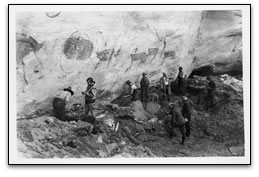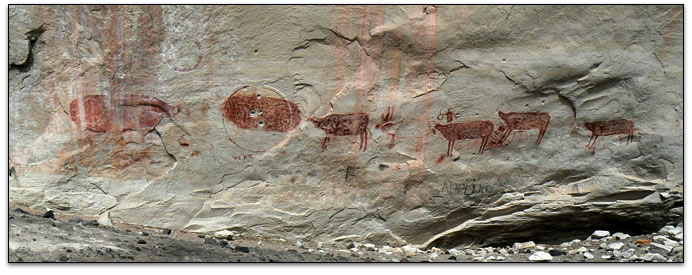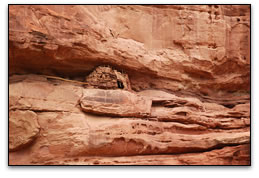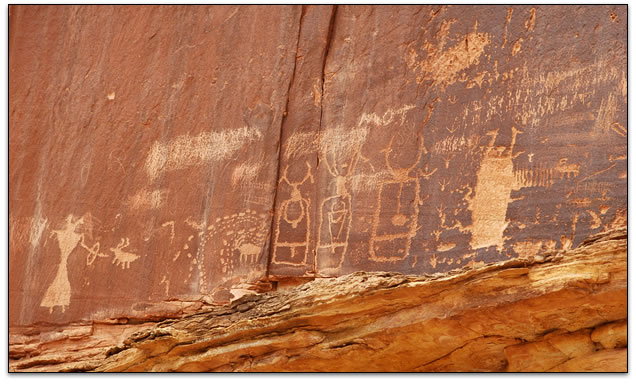The Capitol Reef Project
The Capitol Reef Partnership (CRP) is an unprecedented five-year, on-the-ground public outreach and education initiative directed by CPAA through collaborative partnerships with state, federal and private entities to expose Utah school children and policymakers to the fascinating science of archaeology and to promulgate the protection of archaeology, especially in rural communities, through greater appreciation of the history of scientific research and of the museum collections now scattered across the United States. The initial phase of the project is focused on the archaeology of the Capitol Reef, Torrey and Boulder Mountain area of central Utah where scientists with the Peabody Museum at Harvard University first defined the Fremont Culture during pioneering research from 1928 to 1931. Through scholarships and internships, Utah school children will work side-by-side with professional archaeologists as they identify and evaluate archaeology sites that inspired the emergence of the Fremont Culture concept – a theoretical concept still in use by archaeologists 80 years later. This field work will provide the foundation for the first in a series of region-specific traveling museum exhibits through which “archaeology as science” and “archaeology as history” can be returned to local communities from which artifacts were removed generations ago.

A fundamental component of the CRP is to acquire digital copies of the photos taken of archaeological investigations to Utah from the 1890s through the 1940s when Eastern universities and museums sent scores of expeditions into the American West to acquire spectacular museum collections. The photos include depictions of hundreds of archaeological sites before they were ravaged by looters and vandals, as well as scenes of excavations and artifacts now housed at various museums (traveling exhibits may include actual artifacts on loan to the Utah Museum of Natural History, as well as photographs of artifacts). “Then” and “now” photographs will be included in the traveling museum exhibits and will demonstrate the fragile nature of archaeological sites, as well as the need to prevent further degradation of a collective heritage. These exhibits will highlight heritage resources of significance to local communities.
The nature of archaeological research in the first half of the Twentieth Century was such that archaeologists from eastern institutions always hired local guides familiar with the terrain and the location of sites worthy of investigation. Oftentimes, the descendants of these guides still live in the local communities where the investigations were conducted. It is anticipated that historical research into the participants of these early archaeological expeditions will foster significant local appreciation for the history of early scientific inquiry in their communities by providing deep personal connections to the pioneering expeditions. It is also anticipated that such an effort would help ameliorate an emerging antipathy in rural communities where archaeological research is now viewed as an elitist endeavor by outsiders (whether in Salt Lake or Cambridge) to haul away local cultural treasures to distant museums where the artifacts are never seen again.

Goals and Objectives

The overriding objective of the Capitol Reef Partnership is to foster greater understanding of archaeology as a science and a greater appreciation for archaeological and historic resources, especially in rural parts of the state, through a unique and holistic endeavor that will merge museum archival collections, traveling museum exhibits and opportunities for hands-on archaeological research. The ultimate object is to foster greater protection and preservation of cultural resources through public education and outreach. This partnership will be initially focused on central Utah, but will be expanded to include all parts of rural Utah. The initiative could also become the prototype for similar endeavors in Colorado, New Mexico and Arizona.
Initial goals (2008-2009) include:
- An internship program with Utah high schools to support actual field research in Garfield and Wayne counties to locate and document roughly 50 archaeological sites initially identified in 1928 and 1929 by Harvard researcher Noel Morss.
- Conduct historical research into the identities of local residents who assisted with the Harvard expeditions and identify current local residents with historical connections to the research.
- Utilize ongoing investigations into vandalism and site degradation at Fish Creek Cove near Torrey as the foundation of public outreach efforts to generate local support for the project, through tours of the site for local school children, community newspaper coverage of the investigations, and the development of site interpretation materials.
- Begin a one-year process of acquiring thousands of digitized photographs at the Peabody Museum (these will include collections from other parts of the state that will provide the basis for exhibits in 2009 and beyond).
- Initiate the process with the Utah Division of State History and Utah Museum of Natural History of designing a traveling museum exhibit of historic and modern photographs (then and now), as well as selected artifacts, with the initial exhibit focused on the Fremont Culture of Wayne County and eastern Garfield County.
- Create the template for future region-specific exhibits related to Escalante and Kanab (e.g., Grand Staircase-Escalante National Monument); St. George, Parowan and Cedar City; Blanding, Bluff and Monticello; Vernal, Roosevelt and Duchesne; Richfield, Salina and Clear Creek; Delta and the West Desert; and the cave sites of northeastern Utah (Box Elder and Tooele counties).

Budget
The 2008-2009 twelve-month budget of $185,000 for the Capitol Reef Project requires substantial commitment and participation from private partners. The scholarship-internship component to initial field work to identify and document sites first identified in 1928 and 1929 will involve considerable logistical support for students (food, transportation, etc.) that is estimated at $35,000. Digitization of Peabody Museum photographs will cost $40,000 (this includes photographs needed for subsequent exhibits beyond 2009). The development of interpretive brochures or other media related to the exhibits is anticipated at about $10,000. And the actual development of the multi-media exhibit, related public outreach and interpretive materials, and actual delivery of the exhibit to rural communities is estimated at $100,000. It is anticipated that this budget amount will remain at $185,000 a year over the life of the project, although line items will change as the project evolves. Based on other CPAA projects, it is anticipated that matching and in-kind contributions (e.g., personnel and logistics) will be 3 to 1 or greater over the next five years.
The Colorado Plateau Archaeological Alliance is a non-profit organization created under the laws of the state of Utah
(Internal Revenue Service 501(c)(3) charitable organization).